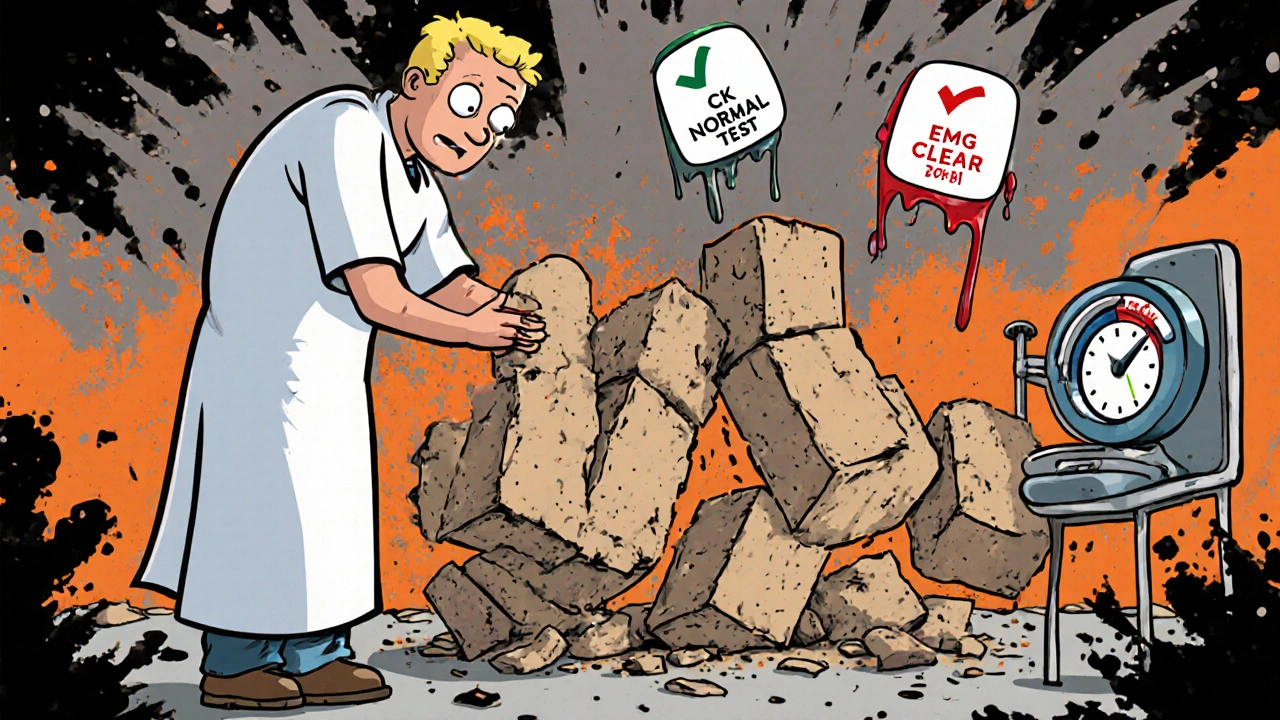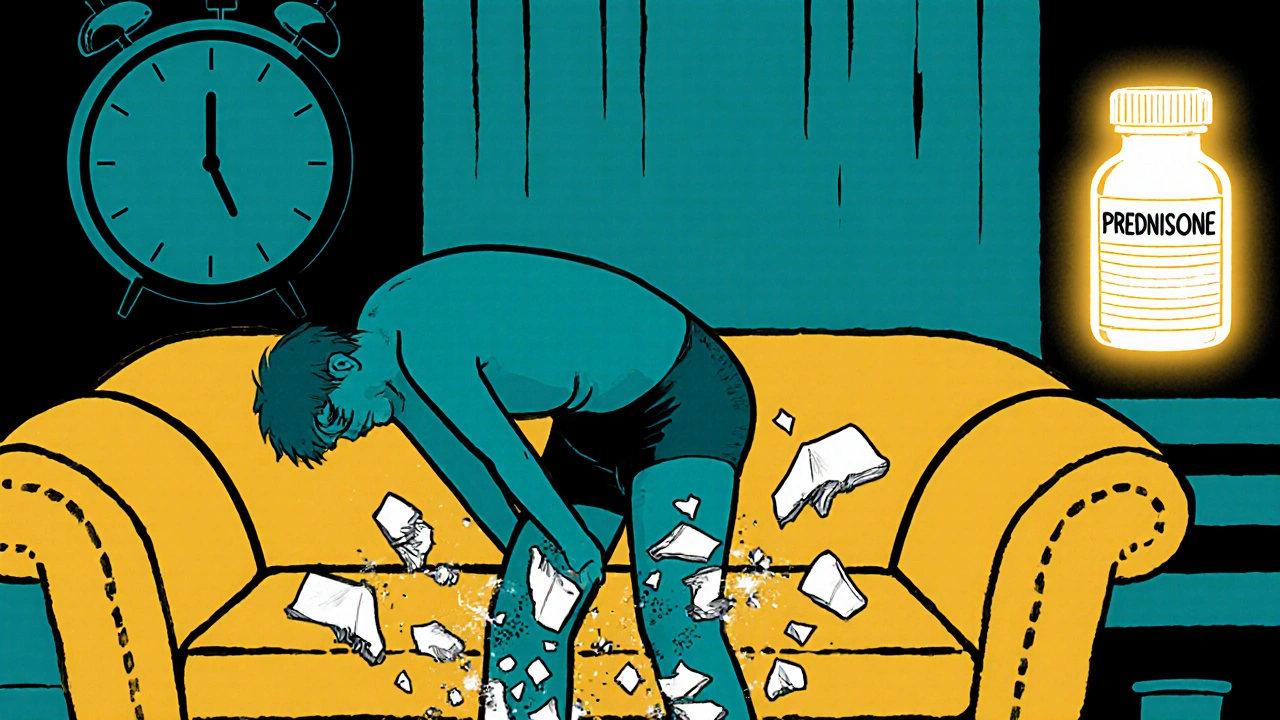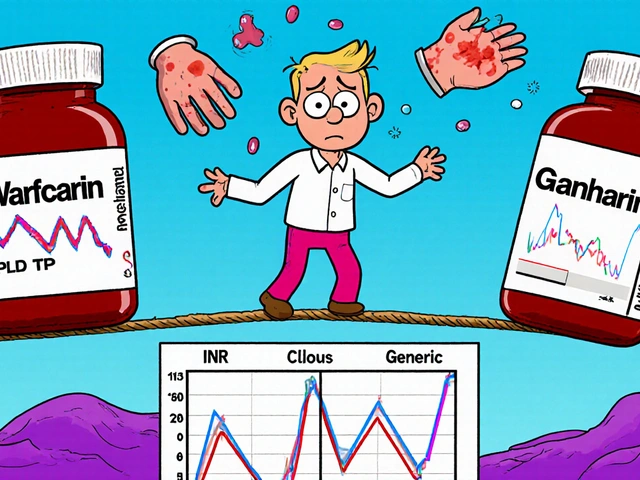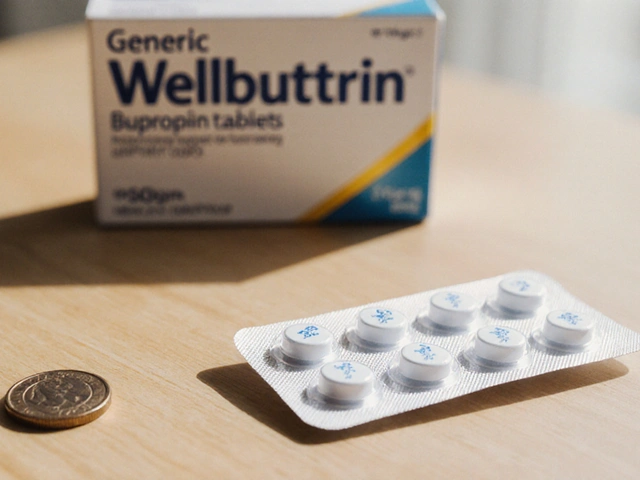Most people know steroids help with inflammation, asthma, or autoimmune diseases. But few realize that taking them long-term can quietly weaken your muscles-without pain, without swelling, and often without warning. This isn’t muscle strain or aging. It’s steroid myopathy, a hidden side effect that affects up to one in five people on daily steroid therapy. And it’s being missed in clinics every day.
What Steroid Myopathy Actually Feels Like
You’re not imagining it. Getting up from a chair feels harder. Climbing stairs takes two hands on the railing. Lifting your arms to reach a high shelf? Impossible without straining. And there’s no ache. No soreness. Just pure, quiet weakness.
This is the classic sign of steroid myopathy: painless, symmetric weakness in the muscles closest to your body’s center-hips, thighs, shoulders. The pelvic girdle gives out first. You might notice you’re using your arms to push yourself up from a sofa, or you’re holding onto walls to stand from the toilet. It’s not laziness. It’s not just being out of shape. It’s your muscle fibers breaking down.
Studies show that 78% of people on long-term steroids have measurable strength loss-even when their doctor says their muscle test looks normal. Why? Manual muscle testing, the kind doctors do with their hands, often misses early damage. You need a dynamometer, a device that measures force, to catch it before it impacts your daily life.
Why Steroids Attack Your Muscles
Steroids like prednisone, dexamethasone, and cortisone work by suppressing your immune system. But they don’t know the difference between harmful inflammation and healthy muscle tissue. Once they bind to receptors in your muscle cells, they flip a switch: turn on muscle breakdown, turn off muscle building.
Inside your muscles, two systems go into overdrive: the ubiquitin-proteasome system and the lysosomal system. Both are like tiny shredders that break down proteins. At the same time, your body stops making new muscle proteins. The result? Fast-twitch muscle fibers-responsible for standing, climbing, lifting-shrink. And they shrink fast. Dexamethasone, often used in cancer treatment, is especially aggressive at this.
Unlike inflammatory muscle diseases, there’s no swelling, no elevated creatine kinase (CK) levels in your blood, and no abnormal signals on an EMG. Your blood tests look clean. That’s why it’s so easy to mistake this for general weakness from your main illness-or just getting older.
Who’s at Risk-and How Fast?
You don’t need to be on high doses for years. Steroid myopathy can start in as little as four weeks if you’re taking more than 10 mg of prednisone daily. In hospitals, patients on IV steroids for severe illness can develop severe weakness in just 2-3 weeks. About 15-20% of these patients end up needing help breathing because their diaphragm weakens.
People with asthma, COPD, rheumatoid arthritis, lupus, or those on long-term immunosuppressants after organ transplants are most at risk. In fact, steroid myopathy is the most common drug-induced muscle disorder-making up 65% of all medication-related muscle weakness cases. And yet, only about a third of rheumatology and pulmonology clinics regularly screen for it.
Patients report waiting an average of five months before someone connects the dots. One Reddit user described it perfectly: “I could feel my legs giving out, but every doctor said, ‘It’s your arthritis getting worse.’”

How to Spot It Early
Don’t wait for a fall or a hospital visit. Ask yourself these questions:
- Can I stand from a chair without using my arms?
- Do I need to hold onto something to climb stairs?
- Can I lift my arms above my head to brush my hair?
If you answered no to any of these, you might already have early steroid myopathy.
Clinicians use simple, reliable tests:
- Timed Chair Rise Test: How long does it take to stand from a chair five times without using your arms? Normal is under 10 seconds. Over 15 seconds is a red flag.
- Gower’s Maneuver: If you have to crawl up your legs to stand from the floor, your hip muscles are failing.
- Shoulder Abduction Test: Can you lift your arms sideways to shoulder height? Weakness here often shows up before leg weakness.
These tests are quick, free, and 89% accurate at catching early cases. If your doctor doesn’t know them, ask for them.
Physical Therapy: The Only Proven Fix
Stopping steroids isn’t always an option. But you don’t have to accept weakness. Physical therapy isn’t just helpful-it’s essential.
Research shows that moderate resistance training can reverse muscle loss. A 2020 trial with 45 patients on steroids found that those who did supervised strength training improved their chair-rise time by 23.7%. The control group, who didn’t train, only improved by 8.2%.
Here’s what works:
- Start low: Use 30% of your one-rep max. That’s light-think lifting a bag of groceries, not a dumbbell.
- Focus on big movements: Squats, step-ups, seated leg presses, and wall push-ups target the weak muscles.
- Go slow: Increase weight by only 5-10% every two weeks. Too fast, and you risk more breakdown.
- Frequency matters: Two to three sessions a week is the sweet spot. Daily workouts can backfire.
Never do high-intensity training, heavy lifting, or long cardio sessions. These stress muscles already under chemical attack. Stick to controlled, consistent movement. And always work with a physiotherapist who understands steroid myopathy-not just general rehab.
What Doesn’t Work
Stretching alone won’t fix it. Massage won’t fix it. Supplements like creatine or protein shakes? They help a little, but they don’t reverse the muscle breakdown caused by steroids. The only thing that rebuilds strength is mechanical loading-your muscles pushing against resistance.
And don’t assume stopping steroids will fix it. While weakness can improve after reducing the dose, muscle recovery takes months-even years-without active training. Your body won’t rebuild itself on its own.

What’s Coming Next
Scientists are working on new drugs called selective glucocorticoid receptor modulators (SEGRMs). One, called Vamorolone, showed 40% less muscle loss than prednisone in trials-while keeping the anti-inflammatory benefits. It’s not widely available yet, but it’s a sign that the medical world is finally paying attention.
The International Myopathy Guidelines Consortium is also finalizing the first global physical therapy protocol for steroid myopathy, expected by the end of 2023. That means standardized care, better training for therapists, and fewer people slipping through the cracks.
What You Can Do Today
1. Track your strength: Do the chair-rise test once a week. Write it down. If it takes longer than before, it’s a signal.
2. Ask your doctor: “Could this weakness be from the steroids? Can we test it?”
3. Find a physiotherapist: Look for one experienced in neuromuscular or endocrine conditions. Don’t settle for generic rehab.
4. Start moving: Even light resistance training-bodyweight squats, seated leg extensions-can make a difference in six weeks.
Steroid myopathy isn’t a death sentence. It’s a silent problem with a simple solution: awareness and movement. You don’t have to lose your independence to stay alive. With the right approach, you can keep standing-on your own.
Is steroid myopathy reversible?
Yes, but only with the right intervention. Reducing steroid dose helps, but muscle recovery requires targeted resistance training. Without exercise, weakness can persist for months or years. Studies show supervised strength training can restore up to 25% of lost strength in 12 weeks.
Do all steroids cause muscle weakness?
Not equally. Prednisone and cortisone cause weakness at doses over 10 mg/day for more than four weeks. Dexamethasone is more potent and can cause myopathy faster-even at lower doses. Inhaled or topical steroids rarely cause muscle issues because they don’t reach systemic levels. The risk is highest with daily oral or IV use.
Can blood tests detect steroid myopathy?
No. Creatine kinase (CK), the usual muscle damage marker, stays normal in steroid myopathy. EMG results are also typically normal. This is why it’s often missed. Diagnosis relies on clinical signs-painless proximal weakness-and functional tests like the timed chair rise, not lab work.
How is steroid myopathy different from polymyositis?
Polymyositis is an inflammatory disease where the immune system attacks muscle fibers. It causes pain, elevated CK levels, and abnormal EMG patterns. Steroid myopathy is a toxic effect-no inflammation, no pain, normal CK, and type 2b muscle fiber atrophy on biopsy. Steroids treat polymyositis but cause steroid myopathy. They look similar but are completely different.
Can I still exercise if I have steroid myopathy?
Yes-but not all exercise is safe. High-intensity workouts, heavy lifting, or long cardio sessions can worsen muscle breakdown. Stick to moderate resistance training: 2-3 times a week, using light to moderate weights (30-60% of your max). Focus on controlled movements and avoid pain. Always work with a physiotherapist who understands this condition.
How long does it take to recover from steroid myopathy?
Recovery varies. With consistent strength training, most people see improvement in 6-12 weeks. Full recovery can take 6-18 months, especially if steroid use continues. The key is starting early. The longer weakness goes untreated, the harder it is to regain function. Delayed diagnosis often leads to permanent mobility loss.
Are there any supplements that help?
Protein intake and vitamin D support general muscle health, but they don’t reverse steroid-induced breakdown. Creatine may offer minor benefits in some studies, but it’s not a substitute for resistance training. The only proven method to rebuild muscle is mechanical loading-your muscles working against resistance. Supplements alone won’t fix it.
Can steroid myopathy affect breathing?
Yes, especially in acute cases with high-dose IV steroids in ICU settings. The diaphragm and other respiratory muscles can weaken, leading to breathing difficulty. About 15-20% of critically ill patients on high-dose steroids require mechanical ventilation due to respiratory muscle weakness. This is less common in chronic outpatient cases but still possible if weakness is severe and untreated.
What to Do Next
If you’re on long-term steroids and notice any change in your ability to stand, climb, or lift-don’t wait. Talk to your doctor. Ask for a strength assessment. Find a physiotherapist who knows how to treat steroid myopathy. Start light resistance training now. You don’t need to be strong to begin-you just need to begin.




Matthew Mahar
November 24, 2025 AT 01:09I legit thought I was just getting old until I couldn’t stand up from my couch without using my hands. My rheumatologist laughed when I brought it up. Then I found this post. Holy shit. I’ve been on prednisone for 3 years. I’m starting squats tomorrow. No more excuses.
Also, I typed this on my phone with one hand because my other arm is too weak to hold it. So sorry if there are typos. I’m literally typing with my chin right now.
John Mackaill
November 25, 2025 AT 10:18This is exactly why we need better screening protocols. I work in a UK clinic and we’ve had three patients in the last year who ended up in rehab because no one checked their functional strength. Blood tests looked fine. They were told to ‘just stay active.’
Functional tests like the chair rise? Free. Takes 30 seconds. Why aren’t we doing this on every steroid patient? It’s not just negligence-it’s systemic failure.
Adrian Rios
November 26, 2025 AT 08:54Let me just say this as someone who’s been on high-dose dexamethasone for lupus nephritis for 18 months-I almost lost my independence. I couldn’t lift my daughter. I couldn’t carry groceries. I thought I was just depressed or tired. The fact that this condition has no pain, no swelling, no elevated CK-it’s like a silent thief.
And yes, the physical therapy worked. Not magic. Not overnight. But after 10 weeks of twice-weekly sessions with a therapist who actually knew what steroid myopathy was, I went from 22 seconds on the chair rise to 9. I cried. Not because I was strong, but because I finally felt like myself again.
Don’t let your doctor dismiss this because your labs are clean. Your body is screaming in a language they stopped listening to. Ask for the Timed Chair Rise. Demand it. And if they don’t know it? Find a new doctor. Your mobility isn’t optional. It’s your right.
Also, the part about Vamorolone? I’m already on the waiting list for the trial. If we can get rid of this side effect without losing the anti-inflammatory power? That’s the future we need.
And to anyone reading this who’s scared to start lifting: start with a water bottle. Seriously. One arm, 5 reps, 3x a week. You don’t need a gym. You just need to begin. I did. And I’m still standing.
Also, thank you for writing this. I’ve been trying to tell people for years. No one listened. Now they might.
Also, I’m not crying. You’re crying.
Katy Bell
November 28, 2025 AT 06:53I’m 52, on prednisone for PMR, and I thought my weakness was just ‘aging with chronic illness.’ This post made me cry in the grocery store. I’ve been using the cart to stand up from the bench. I didn’t know it was the steroids. I thought I was just lazy.
I’m calling my PT tomorrow. And I’m telling my doctor to stop acting like this is normal. It’s not.
Also, I just did a chair rise without using my arms. Took me 14 seconds. I’m not proud. But I’m trying.
Ragini Sharma
November 30, 2025 AT 05:58so like... i’ve been taking 5mg prednisone for my eczema for 8 months and i can’t lift my coffee mug without my arm shaking? is this the thing? or am i just a weak potato? 🤔
also why is no one talking about this?? my dr just says ‘drink more water’ and i’m like… i can’t even reach the fridge to get it 😭
Vivian C Martinez
November 30, 2025 AT 11:51For anyone reading this and feeling overwhelmed-start small. Seriously. Two bodyweight squats against the wall. Three times a week. That’s it. You don’t need to lift heavy. You don’t need to sweat. You just need to move. Muscle memory doesn’t disappear overnight, and it doesn’t come back overnight. But it *does* come back.
And if you’re on steroids, your body is already under stress. Don’t add pressure by trying to do too much too fast. Progress is measured in weeks, not days. Celebrate the tiny wins: standing without help, reaching a shelf, lifting your child. Those are victories.
I’ve seen patients go from wheelchair to walking with a cane in 4 months with consistent, gentle training. It’s not glamorous. But it’s real. And you deserve it.
Also, if you’re reading this and you’re a clinician-stop relying on CK. Start asking questions. Start testing. Your patient’s life depends on it.
Ross Ruprecht
December 1, 2025 AT 18:43Wow, another ‘you’re not lazy’ post. Congrats. You got me to click. Now I’m bored. I’ve been on steroids for 10 years. My legs are weak. Big deal. Everyone’s weak. Go lift something if you care so much. I’ll just keep using my walker. It’s cheaper than therapy.
Also, why is this even a post? Shouldn’t doctors be doing this? Why am I reading this on Reddit instead of my rheumatologist’s office?
Bryson Carroll
December 1, 2025 AT 23:58Look, this whole post is just fearmongering wrapped in a pretty bow. Steroids are life-saving. You think your weak legs are bad? Try being on dialysis or fighting sepsis and then complain about muscle atrophy. This isn’t a crisis-it’s a side effect. A manageable one.
And let’s be real-you’re not going to reverse muscle loss with squats and water bottles. That’s gym bro logic. You need real medicine, not TikTok rehab. Also, Vamorolone? Still experimental. Stop acting like it’s a miracle cure. And who the hell are you to tell doctors how to test for this? You’re not a physio. You’re not even a patient. You’re just someone who read a paper and thinks they’re an expert.
Also, the tone is condescending. You act like everyone’s ignorant. But you’re the one who didn’t understand the science. Steroid myopathy isn’t mysterious. It’s just not glamorous. And that’s why you’re making it into a movement. Sad.